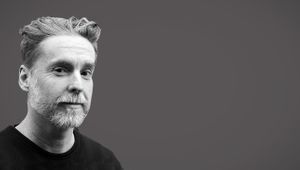
Jumbla's Latest Film Explores New Visual Dimensions By Utilising Adobe Element 3D

Much like the video games themselves, the quality of game cinematics has exponentially increased over the past decade.
Characterising the theme and tone of a new title, gameplay is no longer the deciding factor as to whether gamers make a purchase. It’s all about generating hype around a title before release with a stand-out video, and new sequence Valley of the Kith does exactly that.
Valley of the Kith from Jumbla on Vimeo.
The four minute cinematic film from Melbourne and London-based animation and motion graphics studio Jumbla is a mysterious, high-adrenaline video game-style piece, which was created for experimental purposes. Valley of the Kith was a studio side project, with the idea behind it being to showcase the quality of work that could be achieved by pushing the boundaries of Adobe products – Element 3D in particular.
Jumbla founder, executive creative director and lead on this project, Callan Woolcock, comments: “We wanted to push the limits of the Adobe software to see if we could get high-end visuals using this product.”
Keen to highlight the capabilities of this highly underrated 3D plug-in, Cal and a few members of the Jumbla team set to work on an idea that the creative director had mapped out a while before.
“The overall setting was inspired by a sci-fi film script that I wrote a long time ago, so that gave us a bit of context for the narrative,” he says. “I put together a concept document that detailed everything – the setting, location, vehicles, even the fuel source that powered them. This was used internally to help the team working on it to really understand what they were creating.”
Cal also had a clear idea about the final edit of the piece, which followed the footsteps of other very successful directors.
“Parts of the editing style were influenced by the early works of Neil Blomkamp,” he says. “His short films have this very raw and real style about them, which is something he’s maintained in his feature film productions. He did this thing in his Halo short film where he had these quick cuts during action sequences to far away cameras or satellites, which I thought was cool and unique but really gave the scene a sense of scale.
“That was something I drew from in the Valley of the Kith. It was important to me that these graphical elements helped tell the story, too, and didn’t feel arbitrary in any way. And it works – if you remove these shots the story doesn’t make any sense at all.”
Cal also drew inspiration from the style of legendary movie director Christopher Nolan.
“I watched the making of the Dark Knight a while ago, and they talked about how they changed aspect ratios during shots to cater for IMAX screens. When watching the film, I never even noticed this, so I thought that it would be cool to do something like this – where the shots would change aspect ratio without anyone really noticing too much. This also gives us different feelings when watching the film – certain shots feel more enclosed as if we’re trapped, whereas others feel much more free and open.”
With the narrative and look development nailed, the next stage was figuring out how to bring the sequence to life. Specialising in motion graphics, After Effects and its Element 3D plug-in are a vital part of the Jumbla team’s toolkit, and Cal saw this project as the perfect opportunity to push the limits of the Adobe software.
“I’ve always wanted to create something like this – a sci-fi action scene/trailer that would usually be made in more traditional 3D software – entirely in After Effects,” he comments. “The idea was very much to use Adobe products as much as possible, and After Effects in particular, without having to move into other software.”
And the team stuck closely to that plan, using other software, including 3ds Max and Cinema 4D, only when models, cloth creation and animation proved unobtainable or too slow and cumbersome within Element 3D. The bulk of the project was created with Adobe After Effects and Element 3D, with characters created using Adobe Fuse and animated using Mixamo.
“We imported free or cheap 3D models that we sourced from the internet into Element 3D, and used a lot of the pre-set models or pack models that came with E3D to create environments,” Cal says. “For example, the garage scene and the mining structure that can be seen in detail at the start of the video were all composed inside Element 3D using this technique.”
Using this almost Adobe-only approach meant using a fraction of the human output that would typically be required to execute such a project using traditional methods. When working out the man hours over a period, Valley of the Kith was completed in just under 12 weeks – most that time with just one artist working on it. A traditional pipeline would’ve seen multiple assets pass through multiple artists over a considerable period. Jumbla’s unique approach to production meant essentially eliminating this pipeline without compromising on quality.
However, despite saving huge amounts of time and money with this innovative approach to 3D animation, the project was anything but plain sailing, and Cal and the Jumbla team encountered several setbacks – both personal and technical – along the way.
With a deadline for completion in place for November 2016, life had other ideas for Cal. The deadline had to be pushed back when his first son was born an entire month early.
“It was a very exciting time for me – but of course that also meant that the project came to a complete halt,” he says. “I took the rest of the year off to be at home with him and my partner.
“I kept saying that I was going to work on this project from home, as it was my ‘other baby’ essentially… but I knew that it would really be impossible and that pretty much turned out to be the case.”=
After some time spent with his new bundle of joy, Cal returned to work with a fresh hunger to get the project completed.
“I went back to work part-time and locked myself in our new edit suite and just got it done,” he says. “This is when the big change happened – I was able to look at the project with fresh eyes and realise that our original concept was far too ambitious and needed a rethink. That’s when I decided to simplify the entire thing and turned the focus around onto creating a much more emotive and simple action sequence.”
Although armed with a simplified project plan, there were still issues from a technical perspective, with Cal encountering numerous limitations within the software that he had to find workarounds for.
“I wanted to have large landscapes with ships flying around moving at great velocity and, well, Element 3D isn’t really meant for that type of stuff,” he explains. “For example, having too many 3D objects inside Element 3D across such huge-scale scenes like deserts was unworkable for the most part. I tried various techniques to get this to work, such as creating several smaller environments with rocks and trees, etc, that acted as particles and then spread them out randomly across a plane emitter to create a huge scene. But then I found, at times, that the shadows would just switch off and there was absolutely no way they would turn back on… I’d literally have to rebuild the entire scene from scratch in a different composition.”
To solve this issue, Cal decided to use one large piece of geometry with a sandy texture when creating the desert scenes.
“It was nowhere near as exciting, but I figured by doing this and adding the detail in the fog and atmosphere effects it would work,” he says. “Early on I had created a lot of foliage and plants using textured planes with alpha channels, like how you would create this stuff in actual video games – but things like shadows and fog and ambient occlusion inside of Element 3D did not take the alpha channel into consideration. So, if fog was affecting a layer, for example, then you’d see these white boxes instead of plants all over the place. I got in touch with Video Copilot [maker of the Element 3D plug-in] to see if there was a way you could exclude layers from fog, but there wasn’t, so I just had to remove it entirely.”
And the limitations with Element 3D didn’t end there.
“I also found out early on that Element 3D only reads a total of eight After Effects lights,” he explains. “This was a hurdle, but one that I could overcome – it just meant being a bit smarter about how I went about lighting scenes. The garage scene at the start uses all eight lights and I would have loved to put more in place, and the final shot also uses eight, but for everything else we’re basically just running with one large parallel light that acts as sunlight. This didn’t bother me so much because it was kind of challenging – and I actually only ever intended to use one sun light anyway for the desert scenes as it felt a little more realistic.”
The scale of the world also proved challenging.
“I wanted the ships to be moving extremely quickly and cover a large-scale space, so I scaled all the objects down to be quite small but this made it more difficult to control,” Cal says. “This was also limiting because plug-ins like Particular, when using the box emitter to create atmosphere particles, only work on a world scale of something like 32 thousand pixels. But I was moving through about double that size for a lot of shots. To fix that I just had to have duplicate particle layers and used the world-transform option to push the emitter back even further in zspace. And, of course, in AE I like to keep stuff as minimal as possible so you don’t have comps with hundreds of layers, so stuff like this can get confusing quickly. I wish After Effects had layer groups… just for organisational purposes. I really don’t know why it isn’t a feature.”
Despite the challenges, Cal and the Jumbla team’s high-quality cinematic has done what it set out to and more, proving not only the capabilities of the software but the extensive talent and skill sets of the artists behind it. In fact, the team are so pleased with the outcome, they are making projects like this a staple part of their development process.
“We’re going to be investing and scheduling these projects into the studio as if they are client jobs, and we will not be moving them,” Cal comments.










